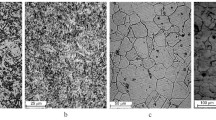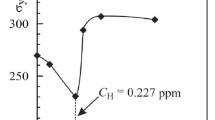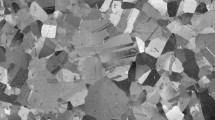Abstract
We present the results of numerical analysis of the influence of the mode of preliminary cyclic loading on hydrogen-induced crack growth in high-strength steel with regard for the stress-strain state and diffusion of hydrogen. The elastoplastic stress-strain state at the crack tip under cyclic loading followed by monotonic loading is simulated for the case of high strains. The diffusion of hydrogen at the crack tip is modeled by taking into account the evolution of the stress-strain state from postcyclic compression to tension in the course of hydrogenation. It is shown that the accumulation of hydrogen in the process zone depends on the distribution of residual stresses induced by cyclic preloading.
Similar content being viewed by others
REFERENCES
R. W. Judy, W. E. King, II, J. A. Hauser, and T. W. Crooker, “Influence of experimental variables on the measurement of stress corrosion cracking properties of high-strength steels,” in: Environmentally Assisted Cracking: Science and Engineering, ASTM STP 1049, American Society for Testing and Materials, Philadelphia (1990), pp. 410–422.
J. Toribio and A. M. Lancha, “Overload retardation effects on stress corrosion behaviour of prestressing steel,” Construct. Build. Mater., 10, 501–505 (1996).
J. Toribio, A. M. Lancha, and M. Elices, “Characteristics of the new tearing topography surface,” Scripta Mater., Metal., 25, 2239–2244 (1991).
H. P. Van Leeuwen, “The kinetics of hydrogen embrittlement: A quantitative diffusion model,” Eng. Fract. Mech., 6, 141–161 (1974).
S. Suresh, Fatigue of Materials, Cambridge University Press, Cambridge (1991).
R. M. McMeeking, “Finite deformation analysis of crack-tip opening in elastic-plastic materials and implications for fracture,” J. Mech. Phys. Solids, 25, 357–381 (1977).
J. Toribio and V. Kharin, “High-resolution numerical modelling of stress-strain fields in the vicinity of a crack tip subjected to fatigue,” in: M. W. Brown, E. R. de los Rios and K. J. Miller (editors), Fracture from Defects (ECF12), EMAS, West Midlands (1998), pp. 1059–1064.
M. F. Kanninen and C. H. Popelar, Advanced Fracture Mechanics, Oxford University Press, Oxford-New York (1985).
K. J. Handerhan and W. M. Garrison, Jr., “A study of crack tip blunting and the influence of blunting behavior on the fracture toughness of ultrahigh-strength steels,” Acta Metal. Materialia, 40, 1337–1355 (1992).
MARC User Information, MARC Analysis Research Corporation, Palo Alto (1994).
J. P. Hirth, “Effects of hydrogen on the properties of iron and steel,” Met. Trans., 11A, 861–890 (1980).
J. Toribio and V. Kharin, “Evaluation of hydrogen-assisted cracking: The meaning and significance of the fracture mechanics approach,” Nucl. Eng. Design, 182, 149–163 (1998).
V. V. Panasyuk, A. E. Andreikiv, and V. S. Kharin, “A model of crack growth in deformed metals under the action of hydrogen,” Fiz.-Khim. Mekh. Mater., 23, No. 2, 3–17 (1987).
W. W. Gerberich, Y. T. Chen, and C. St. John, “A short-time diffusion correlation for hydrogen-induced crack growth kinetics,” Met. Trans., 6A, 1485–1498 (1975).
V. Panasyuk and V. Kharin, “The influence of hydrogenating environments on crack propagation in metals,” in: P. Scott and R. A. Cottis (editors), Environmentally Assisted Fatigue, Mechanical Engineering Publications, London (1990), pp. 123–144.
V. S. Kharin, “Crack growth in deformed metals under the action of hydrogen,” Fiz.-Khim. Mekh. Mater., 23, No. 4, 9–18 (1987).
J. Toribio and V. Kharin, “K-dominance condition in hydrogen assisted cracking: The role of the far field,” Fatigue Fract. Eng. Mater. Struct., 20, 729–745 (1997).
M. Itatani, Y. Miyoshi, and K. C. Ogura, “A numerical analysis of hydrogen concentration at the crack tip in austenitic stainless steel,” J. Soc. Mater. Sci. Japan, 40, 1079–1085 (1991).
T. P. Perng and C. J. Altstetter, “Effects of deformation on hydrogen permeation in austenitic stainless steels,” Acta Met., 34, 1771–1781 (1986).
O. Kronshtal and V. Kharin, “Influence of material inhomogeneity and variation of temperature on hydrogen diffusion as a risk factor of enhancement of hydrogen degradation of metals,” Soviet Materials Science, 28, 475–486 (1992).
L. E. Malvern, Introduction to the Mechanics of a Continuous Medium, Prentice Hall, Englewood Cliffs (1969).
O. C. Zienkiewicz and K. Morgan, Finite Elements and Approximation, Wiley, New York (1983).
J. Toribio and V. Kharin, “Role of fatigue crack closure stresses in hydrogen-assisted cracking,” in: R. C. McClung and J. C. Newman, Jr. (editors), Advances in Fatigue Crack Closure Measurement and Analysis, Vol. 2, American Society for Testing and Materials, PA (1999), pp. 440–458.
A. J. Kummick and H. H. Johnson, “Deep trapping states for hydrogen in deformed iron,” Acta Met., 28, 33–39 (1980).
Author information
Authors and Affiliations
Rights and permissions
About this article
Cite this article
Toribio, J., Kharin, V. Influence of Cyclic Preloading on the Hydrogen Degradation of Materials. Materials Science 38, 514–525 (2002). https://doi.org/10.1023/A:1022906531433
Issue Date:
DOI: https://doi.org/10.1023/A:1022906531433




